Financial Reporting and AASB Standards: BHP's Fayetteville Acquisition
VerifiedAdded on 2023/06/05
|12
|2385
|412
Case Study
AI Summary
This case study provides a detailed analysis of BHP's acquisition of Fayetteville Oil & Gas in 2011, examining the financial reporting implications and the application of Australian Accounting Standards Board (AASB) standards, particularly AASB 3 and AASB 136. It explores the initial acquisition accounting, including the identification of the acquirer, acquisition date, and measurement of identifiable assets and liabilities. The report further investigates the subsequent impairment losses recognized due to declining natural gas prices, detailing the accounting treatment for impairment under AASB 136. It discusses the factors considered in evaluating the impairment loss and the accounting treatment of investments in subsidiaries, including the recognition of impairment losses in the income statement. The study concludes that while BHP followed relevant AASB standards, the acquisition ultimately resulted in significant losses due to unforeseen market conditions. Desklib offers a range of study tools, including past papers and solved assignments, to aid students in understanding complex financial reporting scenarios.

Running head: FINANCIAL REPORTING
Financial Reporting
Name of the Student
Name of the University
Author Note
Financial Reporting
Name of the Student
Name of the University
Author Note
Paraphrase This Document
Need a fresh take? Get an instant paraphrase of this document with our AI Paraphraser
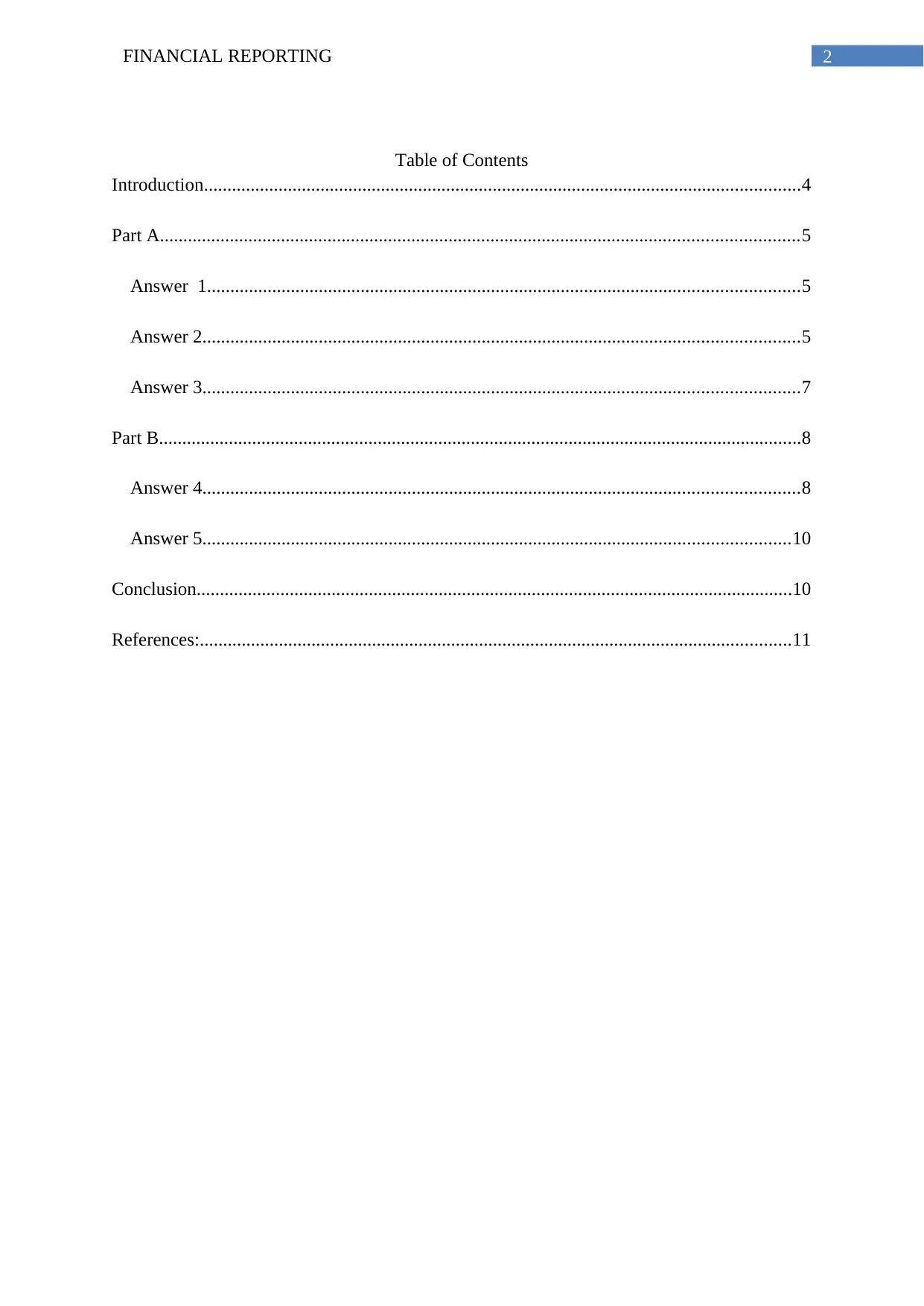
2FINANCIAL REPORTING
Table of Contents
Introduction................................................................................................................................4
Part A.........................................................................................................................................5
Answer 1...............................................................................................................................5
Answer 2................................................................................................................................5
Answer 3................................................................................................................................7
Part B..........................................................................................................................................8
Answer 4................................................................................................................................8
Answer 5..............................................................................................................................10
Conclusion................................................................................................................................10
References:...............................................................................................................................11
Table of Contents
Introduction................................................................................................................................4
Part A.........................................................................................................................................5
Answer 1...............................................................................................................................5
Answer 2................................................................................................................................5
Answer 3................................................................................................................................7
Part B..........................................................................................................................................8
Answer 4................................................................................................................................8
Answer 5..............................................................................................................................10
Conclusion................................................................................................................................10
References:...............................................................................................................................11
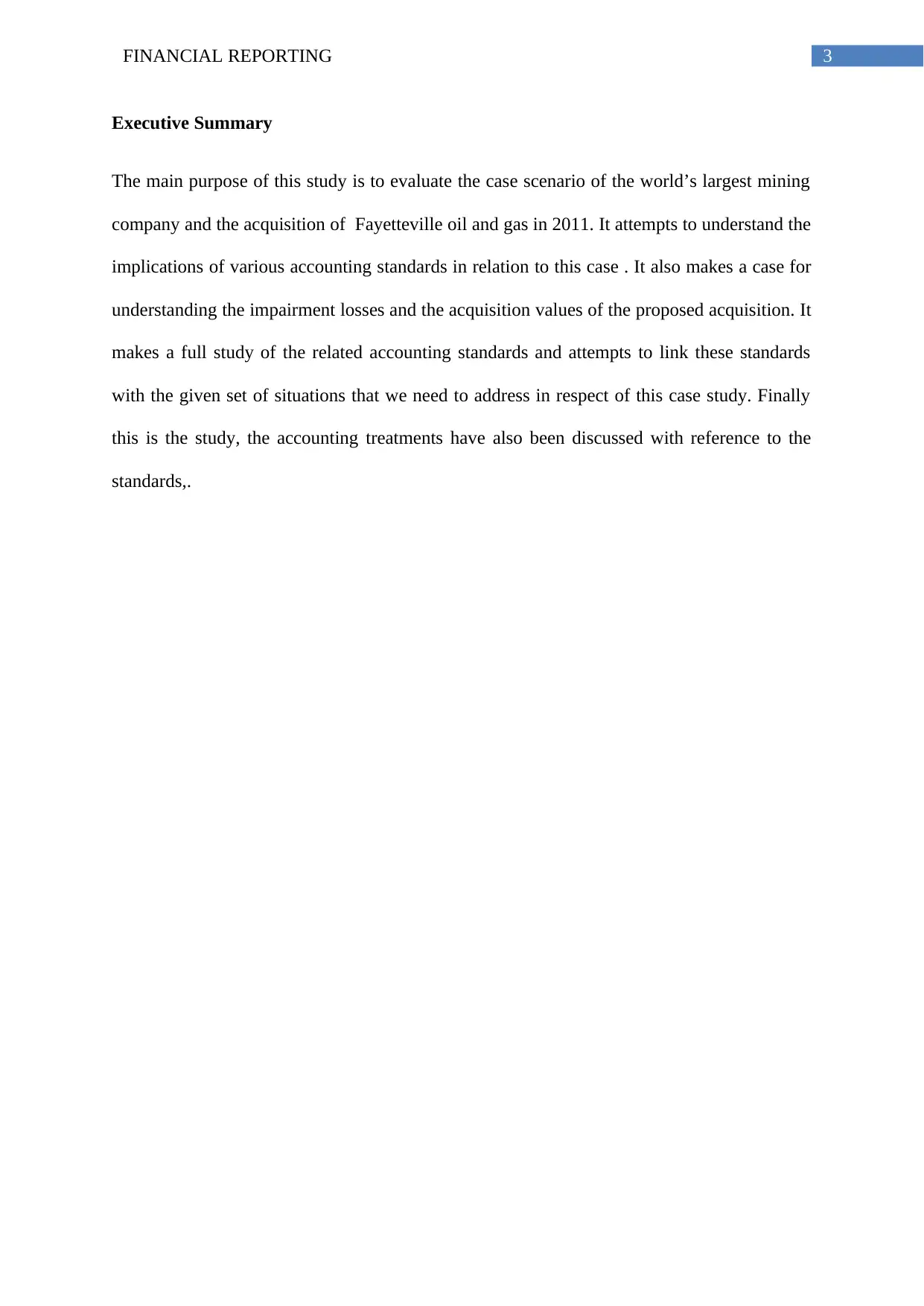
3FINANCIAL REPORTING
Executive Summary
The main purpose of this study is to evaluate the case scenario of the world’s largest mining
company and the acquisition of Fayetteville oil and gas in 2011. It attempts to understand the
implications of various accounting standards in relation to this case . It also makes a case for
understanding the impairment losses and the acquisition values of the proposed acquisition. It
makes a full study of the related accounting standards and attempts to link these standards
with the given set of situations that we need to address in respect of this case study. Finally
this is the study, the accounting treatments have also been discussed with reference to the
standards,.
Executive Summary
The main purpose of this study is to evaluate the case scenario of the world’s largest mining
company and the acquisition of Fayetteville oil and gas in 2011. It attempts to understand the
implications of various accounting standards in relation to this case . It also makes a case for
understanding the impairment losses and the acquisition values of the proposed acquisition. It
makes a full study of the related accounting standards and attempts to link these standards
with the given set of situations that we need to address in respect of this case study. Finally
this is the study, the accounting treatments have also been discussed with reference to the
standards,.
⊘ This is a preview!⊘
Do you want full access?
Subscribe today to unlock all pages.

Trusted by 1+ million students worldwide
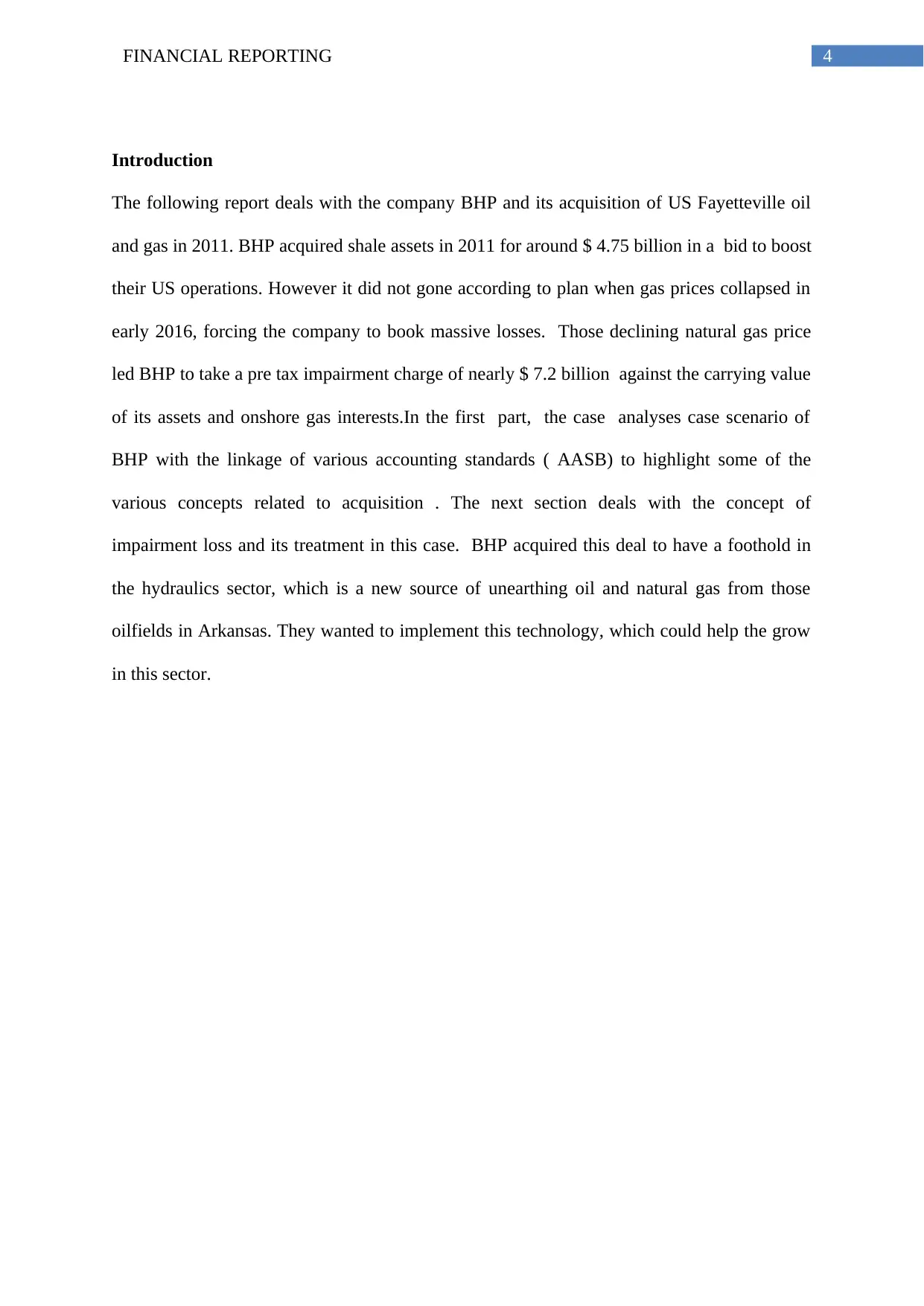
4FINANCIAL REPORTING
Introduction
The following report deals with the company BHP and its acquisition of US Fayetteville oil
and gas in 2011. BHP acquired shale assets in 2011 for around $ 4.75 billion in a bid to boost
their US operations. However it did not gone according to plan when gas prices collapsed in
early 2016, forcing the company to book massive losses. Those declining natural gas price
led BHP to take a pre tax impairment charge of nearly $ 7.2 billion against the carrying value
of its assets and onshore gas interests.In the first part, the case analyses case scenario of
BHP with the linkage of various accounting standards ( AASB) to highlight some of the
various concepts related to acquisition . The next section deals with the concept of
impairment loss and its treatment in this case. BHP acquired this deal to have a foothold in
the hydraulics sector, which is a new source of unearthing oil and natural gas from those
oilfields in Arkansas. They wanted to implement this technology, which could help the grow
in this sector.
Introduction
The following report deals with the company BHP and its acquisition of US Fayetteville oil
and gas in 2011. BHP acquired shale assets in 2011 for around $ 4.75 billion in a bid to boost
their US operations. However it did not gone according to plan when gas prices collapsed in
early 2016, forcing the company to book massive losses. Those declining natural gas price
led BHP to take a pre tax impairment charge of nearly $ 7.2 billion against the carrying value
of its assets and onshore gas interests.In the first part, the case analyses case scenario of
BHP with the linkage of various accounting standards ( AASB) to highlight some of the
various concepts related to acquisition . The next section deals with the concept of
impairment loss and its treatment in this case. BHP acquired this deal to have a foothold in
the hydraulics sector, which is a new source of unearthing oil and natural gas from those
oilfields in Arkansas. They wanted to implement this technology, which could help the grow
in this sector.
Paraphrase This Document
Need a fresh take? Get an instant paraphrase of this document with our AI Paraphraser
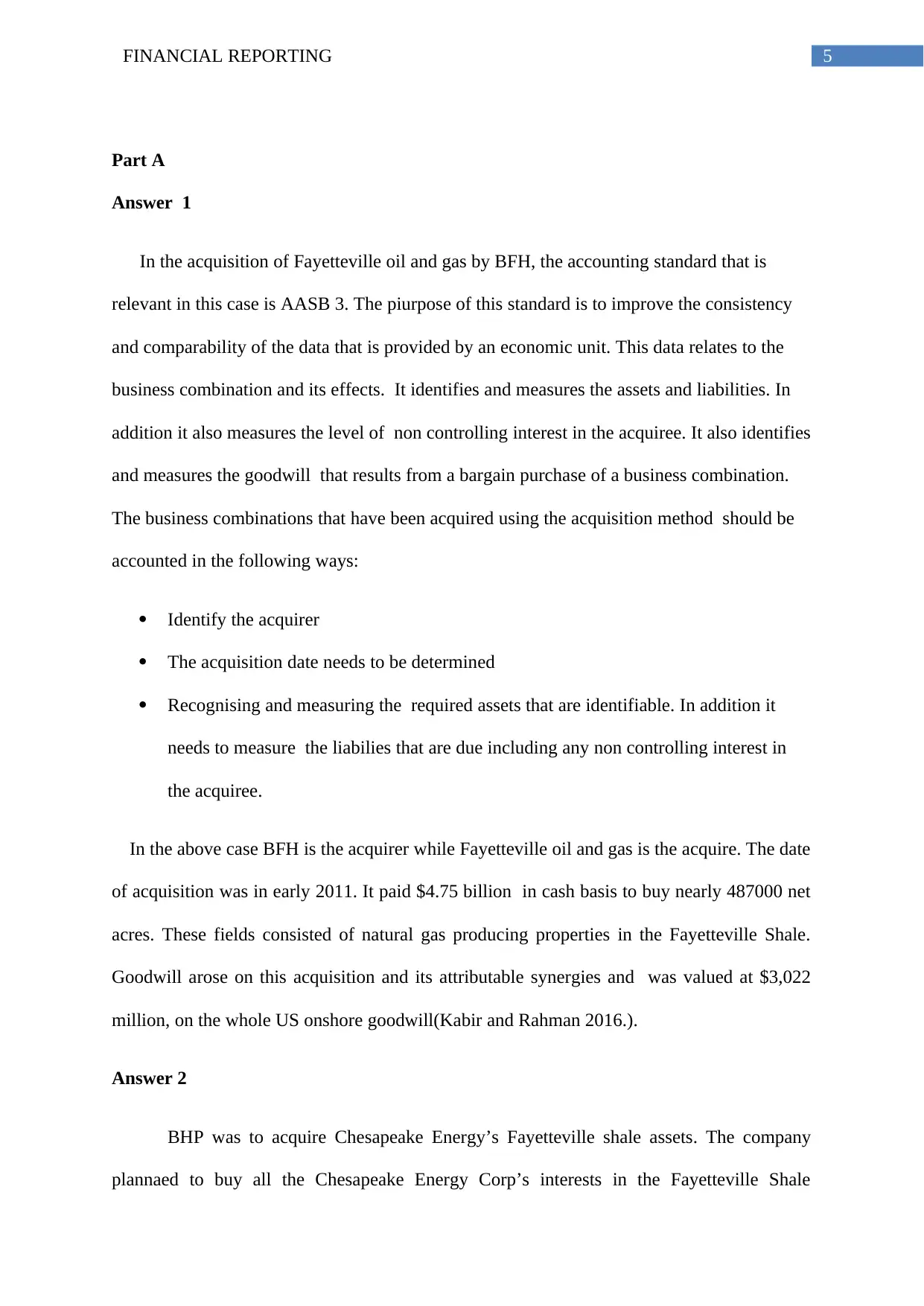
5FINANCIAL REPORTING
Part A
Answer 1
In the acquisition of Fayetteville oil and gas by BFH, the accounting standard that is
relevant in this case is AASB 3. The piurpose of this standard is to improve the consistency
and comparability of the data that is provided by an economic unit. This data relates to the
business combination and its effects. It identifies and measures the assets and liabilities. In
addition it also measures the level of non controlling interest in the acquiree. It also identifies
and measures the goodwill that results from a bargain purchase of a business combination.
The business combinations that have been acquired using the acquisition method should be
accounted in the following ways:
Identify the acquirer
The acquisition date needs to be determined
Recognising and measuring the required assets that are identifiable. In addition it
needs to measure the liabilies that are due including any non controlling interest in
the acquiree.
In the above case BFH is the acquirer while Fayetteville oil and gas is the acquire. The date
of acquisition was in early 2011. It paid $4.75 billion in cash basis to buy nearly 487000 net
acres. These fields consisted of natural gas producing properties in the Fayetteville Shale.
Goodwill arose on this acquisition and its attributable synergies and was valued at $3,022
million, on the whole US onshore goodwill(Kabir and Rahman 2016.).
Answer 2
BHP was to acquire Chesapeake Energy’s Fayetteville shale assets. The company
plannaed to buy all the Chesapeake Energy Corp’s interests in the Fayetteville Shale
Part A
Answer 1
In the acquisition of Fayetteville oil and gas by BFH, the accounting standard that is
relevant in this case is AASB 3. The piurpose of this standard is to improve the consistency
and comparability of the data that is provided by an economic unit. This data relates to the
business combination and its effects. It identifies and measures the assets and liabilities. In
addition it also measures the level of non controlling interest in the acquiree. It also identifies
and measures the goodwill that results from a bargain purchase of a business combination.
The business combinations that have been acquired using the acquisition method should be
accounted in the following ways:
Identify the acquirer
The acquisition date needs to be determined
Recognising and measuring the required assets that are identifiable. In addition it
needs to measure the liabilies that are due including any non controlling interest in
the acquiree.
In the above case BFH is the acquirer while Fayetteville oil and gas is the acquire. The date
of acquisition was in early 2011. It paid $4.75 billion in cash basis to buy nearly 487000 net
acres. These fields consisted of natural gas producing properties in the Fayetteville Shale.
Goodwill arose on this acquisition and its attributable synergies and was valued at $3,022
million, on the whole US onshore goodwill(Kabir and Rahman 2016.).
Answer 2
BHP was to acquire Chesapeake Energy’s Fayetteville shale assets. The company
plannaed to buy all the Chesapeake Energy Corp’s interests in the Fayetteville Shale
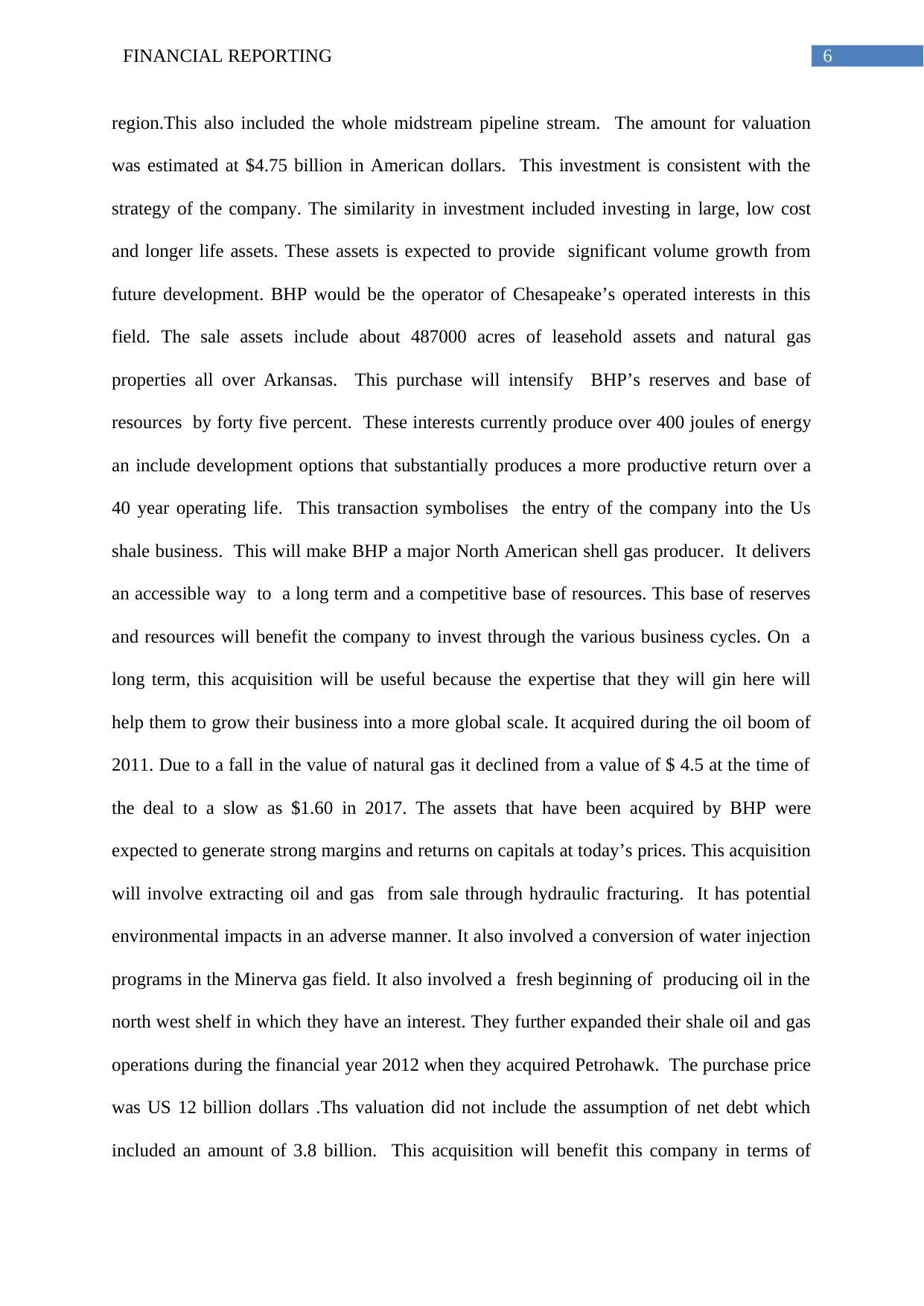
6FINANCIAL REPORTING
region.This also included the whole midstream pipeline stream. The amount for valuation
was estimated at $4.75 billion in American dollars. This investment is consistent with the
strategy of the company. The similarity in investment included investing in large, low cost
and longer life assets. These assets is expected to provide significant volume growth from
future development. BHP would be the operator of Chesapeake’s operated interests in this
field. The sale assets include about 487000 acres of leasehold assets and natural gas
properties all over Arkansas. This purchase will intensify BHP’s reserves and base of
resources by forty five percent. These interests currently produce over 400 joules of energy
an include development options that substantially produces a more productive return over a
40 year operating life. This transaction symbolises the entry of the company into the Us
shale business. This will make BHP a major North American shell gas producer. It delivers
an accessible way to a long term and a competitive base of resources. This base of reserves
and resources will benefit the company to invest through the various business cycles. On a
long term, this acquisition will be useful because the expertise that they will gin here will
help them to grow their business into a more global scale. It acquired during the oil boom of
2011. Due to a fall in the value of natural gas it declined from a value of $ 4.5 at the time of
the deal to a slow as $1.60 in 2017. The assets that have been acquired by BHP were
expected to generate strong margins and returns on capitals at today’s prices. This acquisition
will involve extracting oil and gas from sale through hydraulic fracturing. It has potential
environmental impacts in an adverse manner. It also involved a conversion of water injection
programs in the Minerva gas field. It also involved a fresh beginning of producing oil in the
north west shelf in which they have an interest. They further expanded their shale oil and gas
operations during the financial year 2012 when they acquired Petrohawk. The purchase price
was US 12 billion dollars .Ths valuation did not include the assumption of net debt which
included an amount of 3.8 billion. This acquisition will benefit this company in terms of
region.This also included the whole midstream pipeline stream. The amount for valuation
was estimated at $4.75 billion in American dollars. This investment is consistent with the
strategy of the company. The similarity in investment included investing in large, low cost
and longer life assets. These assets is expected to provide significant volume growth from
future development. BHP would be the operator of Chesapeake’s operated interests in this
field. The sale assets include about 487000 acres of leasehold assets and natural gas
properties all over Arkansas. This purchase will intensify BHP’s reserves and base of
resources by forty five percent. These interests currently produce over 400 joules of energy
an include development options that substantially produces a more productive return over a
40 year operating life. This transaction symbolises the entry of the company into the Us
shale business. This will make BHP a major North American shell gas producer. It delivers
an accessible way to a long term and a competitive base of resources. This base of reserves
and resources will benefit the company to invest through the various business cycles. On a
long term, this acquisition will be useful because the expertise that they will gin here will
help them to grow their business into a more global scale. It acquired during the oil boom of
2011. Due to a fall in the value of natural gas it declined from a value of $ 4.5 at the time of
the deal to a slow as $1.60 in 2017. The assets that have been acquired by BHP were
expected to generate strong margins and returns on capitals at today’s prices. This acquisition
will involve extracting oil and gas from sale through hydraulic fracturing. It has potential
environmental impacts in an adverse manner. It also involved a conversion of water injection
programs in the Minerva gas field. It also involved a fresh beginning of producing oil in the
north west shelf in which they have an interest. They further expanded their shale oil and gas
operations during the financial year 2012 when they acquired Petrohawk. The purchase price
was US 12 billion dollars .Ths valuation did not include the assumption of net debt which
included an amount of 3.8 billion. This acquisition will benefit this company in terms of
⊘ This is a preview!⊘
Do you want full access?
Subscribe today to unlock all pages.

Trusted by 1+ million students worldwide
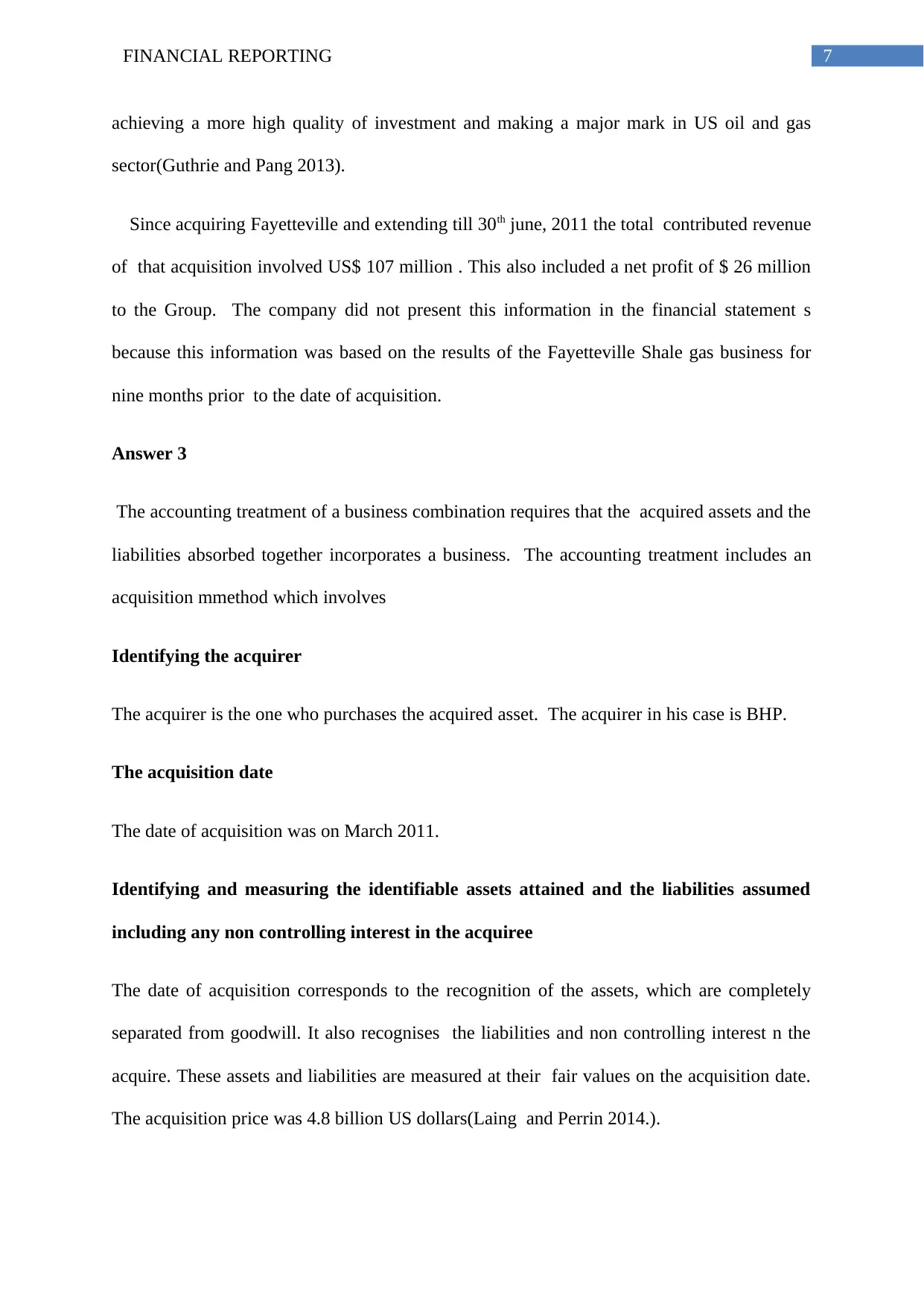
7FINANCIAL REPORTING
achieving a more high quality of investment and making a major mark in US oil and gas
sector(Guthrie and Pang 2013).
Since acquiring Fayetteville and extending till 30th june, 2011 the total contributed revenue
of that acquisition involved US$ 107 million . This also included a net profit of $ 26 million
to the Group. The company did not present this information in the financial statement s
because this information was based on the results of the Fayetteville Shale gas business for
nine months prior to the date of acquisition.
Answer 3
The accounting treatment of a business combination requires that the acquired assets and the
liabilities absorbed together incorporates a business. The accounting treatment includes an
acquisition mmethod which involves
Identifying the acquirer
The acquirer is the one who purchases the acquired asset. The acquirer in his case is BHP.
The acquisition date
The date of acquisition was on March 2011.
Identifying and measuring the identifiable assets attained and the liabilities assumed
including any non controlling interest in the acquiree
The date of acquisition corresponds to the recognition of the assets, which are completely
separated from goodwill. It also recognises the liabilities and non controlling interest n the
acquire. These assets and liabilities are measured at their fair values on the acquisition date.
The acquisition price was 4.8 billion US dollars(Laing and Perrin 2014.).
achieving a more high quality of investment and making a major mark in US oil and gas
sector(Guthrie and Pang 2013).
Since acquiring Fayetteville and extending till 30th june, 2011 the total contributed revenue
of that acquisition involved US$ 107 million . This also included a net profit of $ 26 million
to the Group. The company did not present this information in the financial statement s
because this information was based on the results of the Fayetteville Shale gas business for
nine months prior to the date of acquisition.
Answer 3
The accounting treatment of a business combination requires that the acquired assets and the
liabilities absorbed together incorporates a business. The accounting treatment includes an
acquisition mmethod which involves
Identifying the acquirer
The acquirer is the one who purchases the acquired asset. The acquirer in his case is BHP.
The acquisition date
The date of acquisition was on March 2011.
Identifying and measuring the identifiable assets attained and the liabilities assumed
including any non controlling interest in the acquiree
The date of acquisition corresponds to the recognition of the assets, which are completely
separated from goodwill. It also recognises the liabilities and non controlling interest n the
acquire. These assets and liabilities are measured at their fair values on the acquisition date.
The acquisition price was 4.8 billion US dollars(Laing and Perrin 2014.).
Paraphrase This Document
Need a fresh take? Get an instant paraphrase of this document with our AI Paraphraser
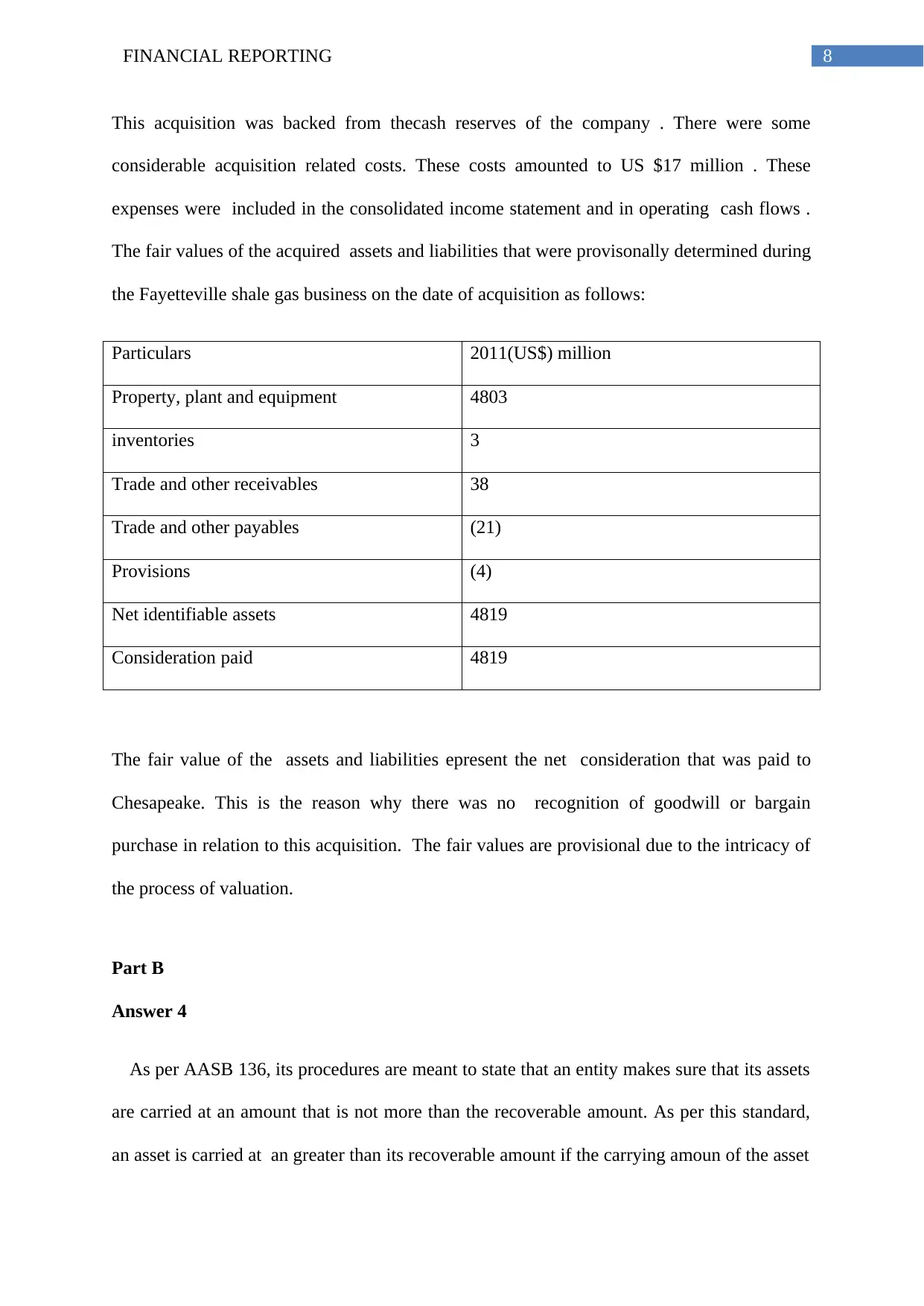
8FINANCIAL REPORTING
This acquisition was backed from thecash reserves of the company . There were some
considerable acquisition related costs. These costs amounted to US $17 million . These
expenses were included in the consolidated income statement and in operating cash flows .
The fair values of the acquired assets and liabilities that were provisonally determined during
the Fayetteville shale gas business on the date of acquisition as follows:
Particulars 2011(US$) million
Property, plant and equipment 4803
inventories 3
Trade and other receivables 38
Trade and other payables (21)
Provisions (4)
Net identifiable assets 4819
Consideration paid 4819
The fair value of the assets and liabilities epresent the net consideration that was paid to
Chesapeake. This is the reason why there was no recognition of goodwill or bargain
purchase in relation to this acquisition. The fair values are provisional due to the intricacy of
the process of valuation.
Part B
Answer 4
As per AASB 136, its procedures are meant to state that an entity makes sure that its assets
are carried at an amount that is not more than the recoverable amount. As per this standard,
an asset is carried at an greater than its recoverable amount if the carrying amoun of the asset
This acquisition was backed from thecash reserves of the company . There were some
considerable acquisition related costs. These costs amounted to US $17 million . These
expenses were included in the consolidated income statement and in operating cash flows .
The fair values of the acquired assets and liabilities that were provisonally determined during
the Fayetteville shale gas business on the date of acquisition as follows:
Particulars 2011(US$) million
Property, plant and equipment 4803
inventories 3
Trade and other receivables 38
Trade and other payables (21)
Provisions (4)
Net identifiable assets 4819
Consideration paid 4819
The fair value of the assets and liabilities epresent the net consideration that was paid to
Chesapeake. This is the reason why there was no recognition of goodwill or bargain
purchase in relation to this acquisition. The fair values are provisional due to the intricacy of
the process of valuation.
Part B
Answer 4
As per AASB 136, its procedures are meant to state that an entity makes sure that its assets
are carried at an amount that is not more than the recoverable amount. As per this standard,
an asset is carried at an greater than its recoverable amount if the carrying amoun of the asset
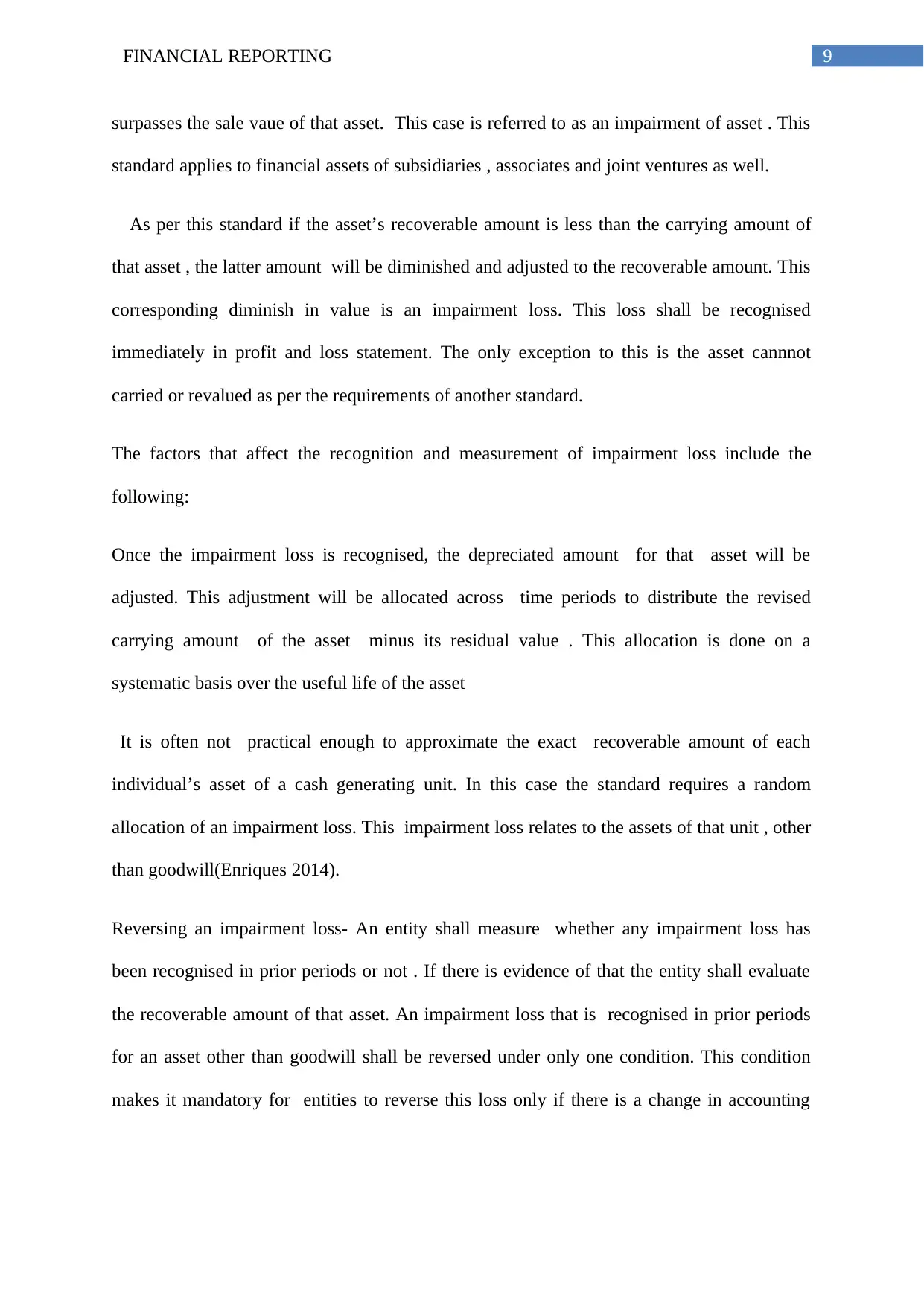
9FINANCIAL REPORTING
surpasses the sale vaue of that asset. This case is referred to as an impairment of asset . This
standard applies to financial assets of subsidiaries , associates and joint ventures as well.
As per this standard if the asset’s recoverable amount is less than the carrying amount of
that asset , the latter amount will be diminished and adjusted to the recoverable amount. This
corresponding diminish in value is an impairment loss. This loss shall be recognised
immediately in profit and loss statement. The only exception to this is the asset cannnot
carried or revalued as per the requirements of another standard.
The factors that affect the recognition and measurement of impairment loss include the
following:
Once the impairment loss is recognised, the depreciated amount for that asset will be
adjusted. This adjustment will be allocated across time periods to distribute the revised
carrying amount of the asset minus its residual value . This allocation is done on a
systematic basis over the useful life of the asset
It is often not practical enough to approximate the exact recoverable amount of each
individual’s asset of a cash generating unit. In this case the standard requires a random
allocation of an impairment loss. This impairment loss relates to the assets of that unit , other
than goodwill(Enriques 2014).
Reversing an impairment loss- An entity shall measure whether any impairment loss has
been recognised in prior periods or not . If there is evidence of that the entity shall evaluate
the recoverable amount of that asset. An impairment loss that is recognised in prior periods
for an asset other than goodwill shall be reversed under only one condition. This condition
makes it mandatory for entities to reverse this loss only if there is a change in accounting
surpasses the sale vaue of that asset. This case is referred to as an impairment of asset . This
standard applies to financial assets of subsidiaries , associates and joint ventures as well.
As per this standard if the asset’s recoverable amount is less than the carrying amount of
that asset , the latter amount will be diminished and adjusted to the recoverable amount. This
corresponding diminish in value is an impairment loss. This loss shall be recognised
immediately in profit and loss statement. The only exception to this is the asset cannnot
carried or revalued as per the requirements of another standard.
The factors that affect the recognition and measurement of impairment loss include the
following:
Once the impairment loss is recognised, the depreciated amount for that asset will be
adjusted. This adjustment will be allocated across time periods to distribute the revised
carrying amount of the asset minus its residual value . This allocation is done on a
systematic basis over the useful life of the asset
It is often not practical enough to approximate the exact recoverable amount of each
individual’s asset of a cash generating unit. In this case the standard requires a random
allocation of an impairment loss. This impairment loss relates to the assets of that unit , other
than goodwill(Enriques 2014).
Reversing an impairment loss- An entity shall measure whether any impairment loss has
been recognised in prior periods or not . If there is evidence of that the entity shall evaluate
the recoverable amount of that asset. An impairment loss that is recognised in prior periods
for an asset other than goodwill shall be reversed under only one condition. This condition
makes it mandatory for entities to reverse this loss only if there is a change in accounting
⊘ This is a preview!⊘
Do you want full access?
Subscribe today to unlock all pages.

Trusted by 1+ million students worldwide
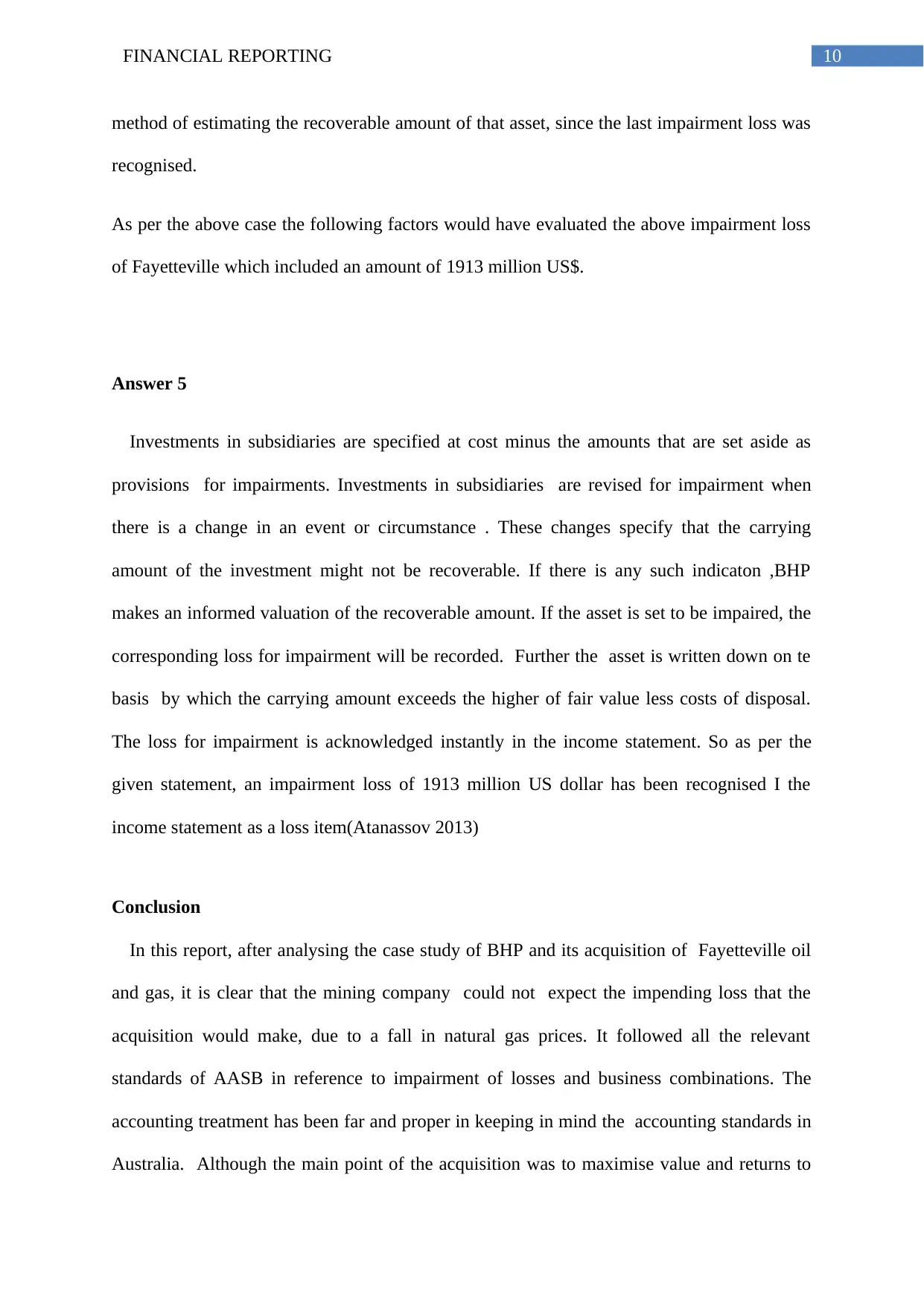
10FINANCIAL REPORTING
method of estimating the recoverable amount of that asset, since the last impairment loss was
recognised.
As per the above case the following factors would have evaluated the above impairment loss
of Fayetteville which included an amount of 1913 million US$.
Answer 5
Investments in subsidiaries are specified at cost minus the amounts that are set aside as
provisions for impairments. Investments in subsidiaries are revised for impairment when
there is a change in an event or circumstance . These changes specify that the carrying
amount of the investment might not be recoverable. If there is any such indicaton ,BHP
makes an informed valuation of the recoverable amount. If the asset is set to be impaired, the
corresponding loss for impairment will be recorded. Further the asset is written down on te
basis by which the carrying amount exceeds the higher of fair value less costs of disposal.
The loss for impairment is acknowledged instantly in the income statement. So as per the
given statement, an impairment loss of 1913 million US dollar has been recognised I the
income statement as a loss item(Atanassov 2013)
Conclusion
In this report, after analysing the case study of BHP and its acquisition of Fayetteville oil
and gas, it is clear that the mining company could not expect the impending loss that the
acquisition would make, due to a fall in natural gas prices. It followed all the relevant
standards of AASB in reference to impairment of losses and business combinations. The
accounting treatment has been far and proper in keeping in mind the accounting standards in
Australia. Although the main point of the acquisition was to maximise value and returns to
method of estimating the recoverable amount of that asset, since the last impairment loss was
recognised.
As per the above case the following factors would have evaluated the above impairment loss
of Fayetteville which included an amount of 1913 million US$.
Answer 5
Investments in subsidiaries are specified at cost minus the amounts that are set aside as
provisions for impairments. Investments in subsidiaries are revised for impairment when
there is a change in an event or circumstance . These changes specify that the carrying
amount of the investment might not be recoverable. If there is any such indicaton ,BHP
makes an informed valuation of the recoverable amount. If the asset is set to be impaired, the
corresponding loss for impairment will be recorded. Further the asset is written down on te
basis by which the carrying amount exceeds the higher of fair value less costs of disposal.
The loss for impairment is acknowledged instantly in the income statement. So as per the
given statement, an impairment loss of 1913 million US dollar has been recognised I the
income statement as a loss item(Atanassov 2013)
Conclusion
In this report, after analysing the case study of BHP and its acquisition of Fayetteville oil
and gas, it is clear that the mining company could not expect the impending loss that the
acquisition would make, due to a fall in natural gas prices. It followed all the relevant
standards of AASB in reference to impairment of losses and business combinations. The
accounting treatment has been far and proper in keeping in mind the accounting standards in
Australia. Although the main point of the acquisition was to maximise value and returns to
Paraphrase This Document
Need a fresh take? Get an instant paraphrase of this document with our AI Paraphraser

11FINANCIAL REPORTING
shareholders in the long term, yet it did not fulfil its expectations. The impairment and value
of the acquisition was appropriately dealt with in the financial statements.
shareholders in the long term, yet it did not fulfil its expectations. The impairment and value
of the acquisition was appropriately dealt with in the financial statements.
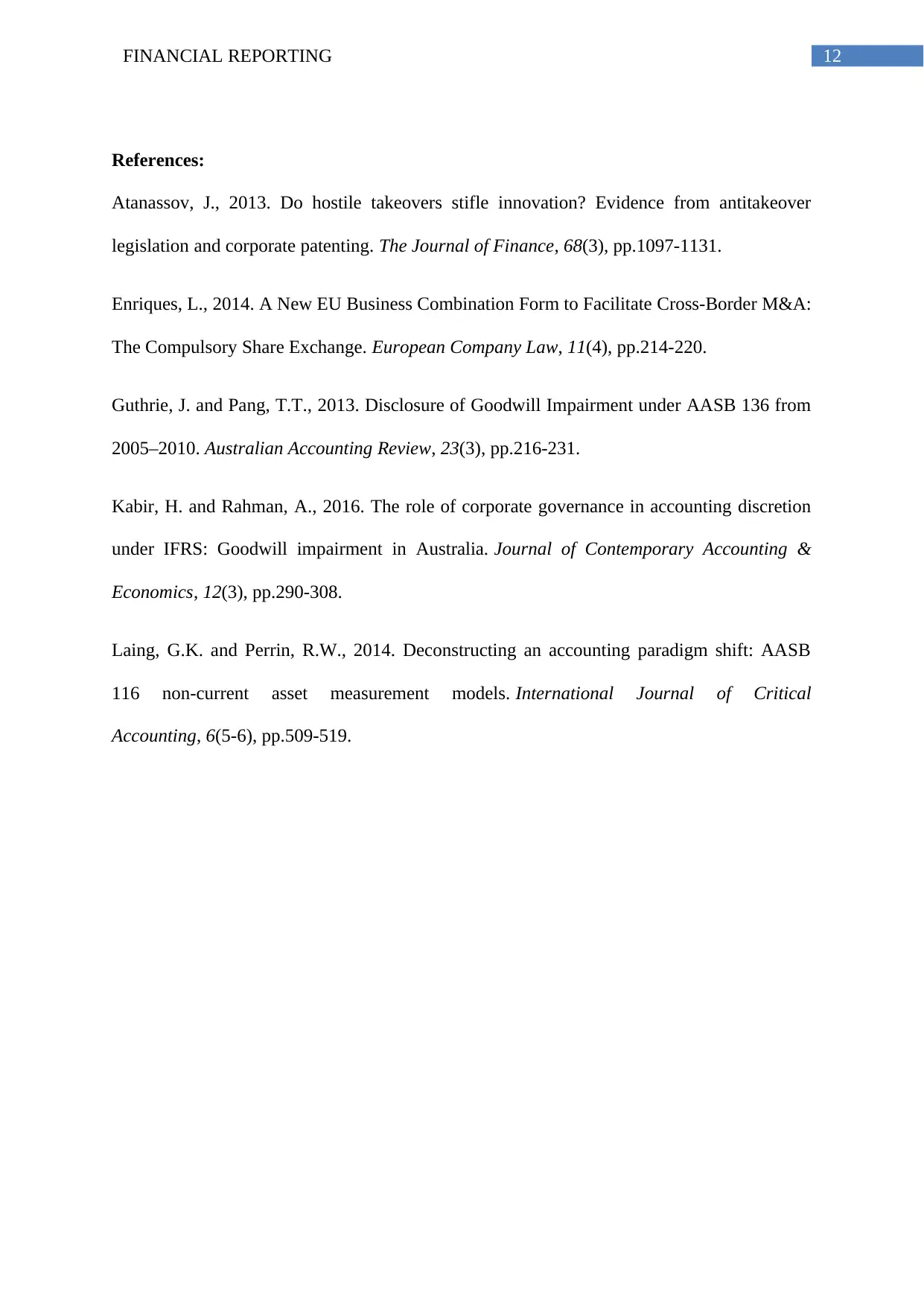
12FINANCIAL REPORTING
References:
Atanassov, J., 2013. Do hostile takeovers stifle innovation? Evidence from antitakeover
legislation and corporate patenting. The Journal of Finance, 68(3), pp.1097-1131.
Enriques, L., 2014. A New EU Business Combination Form to Facilitate Cross-Border M&A:
The Compulsory Share Exchange. European Company Law, 11(4), pp.214-220.
Guthrie, J. and Pang, T.T., 2013. Disclosure of Goodwill Impairment under AASB 136 from
2005–2010. Australian Accounting Review, 23(3), pp.216-231.
Kabir, H. and Rahman, A., 2016. The role of corporate governance in accounting discretion
under IFRS: Goodwill impairment in Australia. Journal of Contemporary Accounting &
Economics, 12(3), pp.290-308.
Laing, G.K. and Perrin, R.W., 2014. Deconstructing an accounting paradigm shift: AASB
116 non-current asset measurement models. International Journal of Critical
Accounting, 6(5-6), pp.509-519.
References:
Atanassov, J., 2013. Do hostile takeovers stifle innovation? Evidence from antitakeover
legislation and corporate patenting. The Journal of Finance, 68(3), pp.1097-1131.
Enriques, L., 2014. A New EU Business Combination Form to Facilitate Cross-Border M&A:
The Compulsory Share Exchange. European Company Law, 11(4), pp.214-220.
Guthrie, J. and Pang, T.T., 2013. Disclosure of Goodwill Impairment under AASB 136 from
2005–2010. Australian Accounting Review, 23(3), pp.216-231.
Kabir, H. and Rahman, A., 2016. The role of corporate governance in accounting discretion
under IFRS: Goodwill impairment in Australia. Journal of Contemporary Accounting &
Economics, 12(3), pp.290-308.
Laing, G.K. and Perrin, R.W., 2014. Deconstructing an accounting paradigm shift: AASB
116 non-current asset measurement models. International Journal of Critical
Accounting, 6(5-6), pp.509-519.
⊘ This is a preview!⊘
Do you want full access?
Subscribe today to unlock all pages.

Trusted by 1+ million students worldwide
1 out of 12
Related Documents
Your All-in-One AI-Powered Toolkit for Academic Success.
+13062052269
info@desklib.com
Available 24*7 on WhatsApp / Email
![[object Object]](/_next/static/media/star-bottom.7253800d.svg)
Unlock your academic potential
Copyright © 2020–2025 A2Z Services. All Rights Reserved. Developed and managed by ZUCOL.





